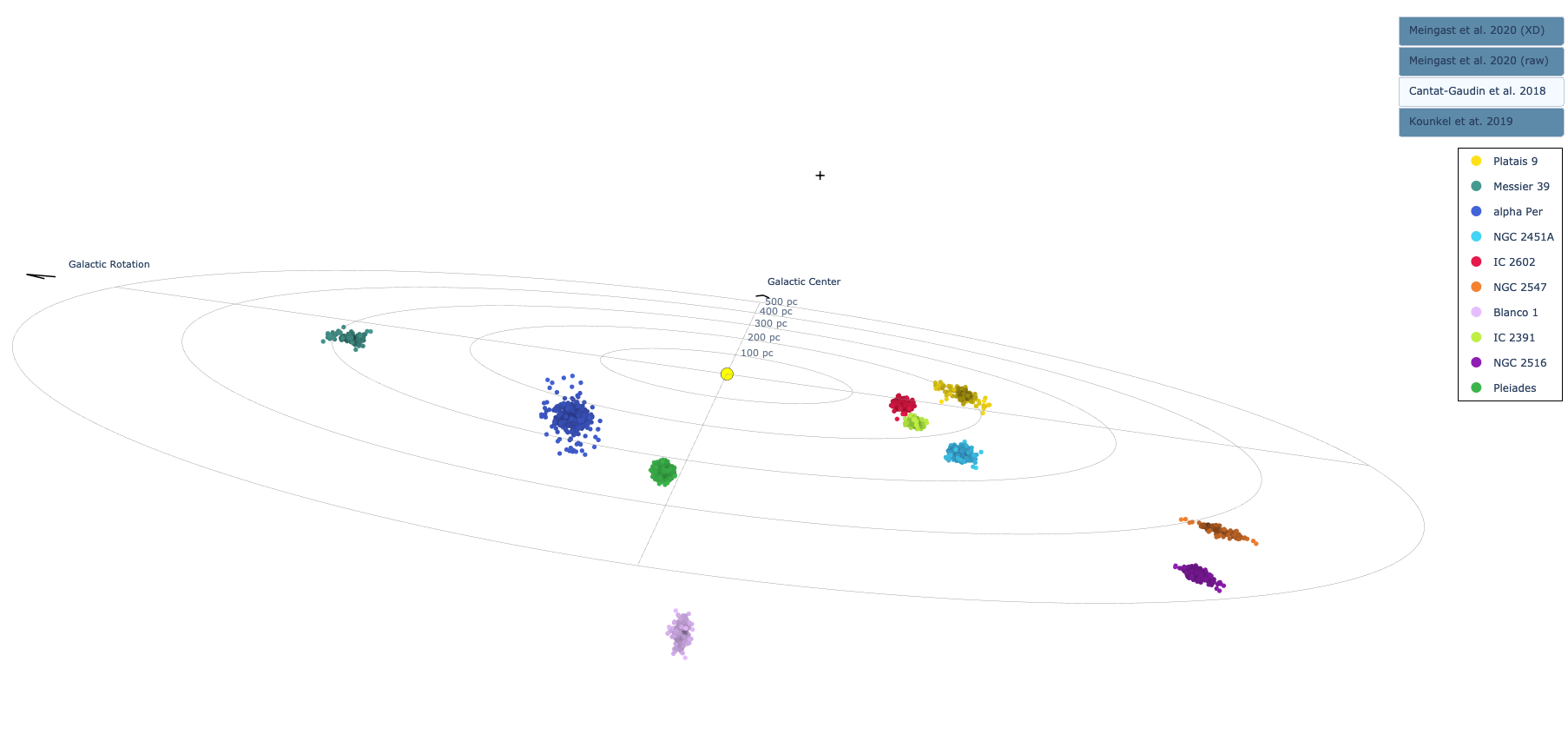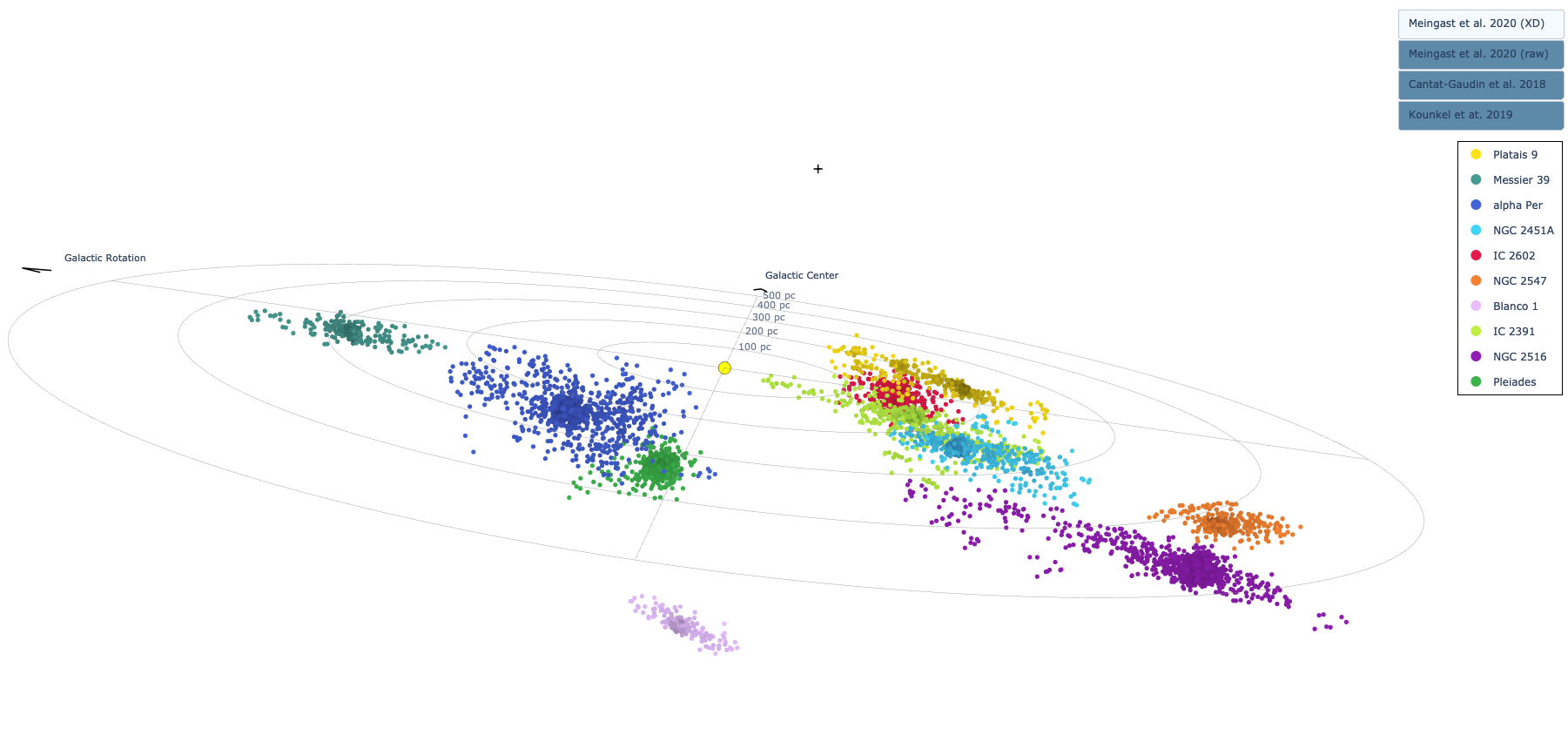IoW_20201015 - Gaia
Image of the Week |
StaR Clusters are only the tip of the iceberg |
|
|
|
An interactive scientific visualisation of the newly discovered populations can be found here. In the above figure, one can see the various clusters highlighted with different colours. Top figure: results based on Cantat Gaudin et al. 2018 as provided in the scientific visualisation. Bottom figure: results based on Meingast et al. 2020 as provided in the scientific visualisation. Credit: Meingast, Alves and Rottensteiner. |
|
Star clusters have been part of the Imaginarium of human civilization for millennia, as shown through the countless representations in arts and sciences across cultures and continents. The closest and brightest star clusters to Earth, like the Pleiades, are readily visible to the naked eye and are prominent members of our night sky, where they appear as tight concentrations of stars. A research team around astronomer Stefan Meingast at the University of Vienna has now revealed the existence of massive stellar halos, termed coronae, surrounding local star clusters. “Clusters form big families of stars that can stay together for large parts of their lifetime. Today, we know of roughly a few thousand-star clusters in the Milky Way, but we only recognize them because of their prominent appearance as rich and tight groups of stars. Given enough time, stars tend to leave their cradle and find themselves surrounded by countless strangers, thereby becoming indistinguishable from their neighbours and hard to identify” says Stefan Meingast, lead author of the paper "Extended stellar systems in the solar neighborhood -- V. Discovery of coronae of nearby star clusters" published in Astronomy & Astrophysics. “Our Sun is thought to have formed in a star cluster but has left its siblings behind a long time ago” he adds. Thanks to the ESA Gaia spacecraft’s precise measurements, astronomers at the University of Vienna have now discovered that, what we call a star cluster is only the tip of the iceberg of a much larger and often distinctly elongated distribution of stars. “Our measurements reveal the vast numbers of sibling stars surrounding the well-known cores of the star clusters for the first time. It appears that star clusters are enclosed in rich halos, or coronae, more than 10 times as large as the original cluster, reaching far beyond our previous guesses. The tight groups of stars we see in the night sky are just a part of a much larger entity.” says Alena Rottensteiner, co-author and master student at the University of Vienna. “It is very exciting for a student to be involved in research like this project. There is plenty of work ahead revising what we thought were basic properties of star clusters, and trying to understand the origin of the newfound coronae.” To find the lost star siblings, the research team developed a new method that uses machine learning to trace groups of stars which were born together and move jointly across the sky. The team analyzed 10 star clusters and identified thousands of siblings far away from the center of the compact clusters, yet clearly belonging to the same family. An explanation for the origin of these coronae remains uncertain, yet the team is confident that their findings will redefine star clusters and aid our understanding of their history and evolution across cosmic time.
A panoramic view of the nearby Alpha Persei star cluster and its corona. The member stars in the corona are invisible against the rich stellar background. These are only revealed thanks to the combination of precise measurements with the ESA Gaia space telescope and innovative machine learning tools. Copyright video: Stefan Meingast, made with Gaia Sky. “The star clusters we investigated were thought to be well-known prototypes, studied for more than a century, yet it seems we have to start thinking bigger. Our discovery will have important implications for our understanding of how the Milky Way was built, cluster by cluster, but also implications for the survival rate of proto-planets far from the sterilizing radiation of massive stars in the centers of clusters” says João Alves, Professor of Stellar Astrophysics at the University of Vienna and a co-author of the paper. “Dense star clusters with their massive but less dense coronae might not be a bad place to raise infant planets after all.” The research team is focussing their efforts to unravel more mysteries surrounding the newly found cluster coronae. Interested students across the world can sign up to join the race to new discoveries via the project "From Coronae to Streams: The true Birthplaces of Stars as part of the Vienna International School of Earth and Space Sciences".
The interactive scientific visualisation of the newly discovered populations has been embedded here, but one might take a look at the original page here. Credit: Meingast, Alves and Rottensteiner.
Story fully based on the press release prepared by the University of Vienna. |
|
Credits: Stefan Meingast, João Alves, Alena Rottensteiner [Published: 15/10/2020] |
- Removed a total of (11) style text-align:center;
- Removed a total of (5) style text-align:justify;
- Removed a total of (1) border attribute.
- Removed a total of (1) cellpadding attribute.
- Removed a total of (1) cellspacing attribute.
- Converted a total of (1) youtube to youtube-nocookie.
Image of the Week Archive
- Removed a total of (1) border attribute.
- Removed a total of (1) cellpadding attribute.
- Removed a total of (1) cellspacing attribute.








































 Sign in
Sign in
 Science & Technology
Science & Technology

